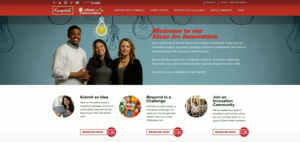Simply striving for innovation isn’t quite enough. Choosing innovation software features or a platform and seem to make things a bit more complicated while getting started. What should you look for in features? What’s important and what isn’t? All questions that we can easily assist you in answering and help you move forward quicker with your innovation strategy.
The right innovation software features are key to the success of your strategy. With the right software, your innovation efforts should feel streamlined, effortless and, ultimately, effective. There seems to be 10 features of interest that you’ll want to look for while choosing your software.
Key Benefits of Innovation Management Software
As you narrow down your options, it helps to know exactly how the right innovation management software can transform the way your organization approaches new ideas. Here’s a quick look at the major benefits you can expect:
1. Supercharged Collaboration (Without the Headaches!)
A great innovation platform tears down those pesky departmental walls and encourages open collaboration. By connecting everyone from marketing to R&D (and even those unlikely duos you never would have paired together), these tools make sure good ideas aren’t lost in someone’s inbox. Features like real-time chat, idea portals, and role-based access help everyone share, refine, and build on each other’s suggestions—making team creativity the norm, not the exception.
2. Streamlined Idea Management
Remember sifting through spreadsheets and endless email chains for new concepts? With the right software, you won’t have to. Automated collection, evaluation, and prioritization keep your innovation pipeline moving smoothly. Customizable workflows and even AI-powered tools make it easy to spot the brightest ideas early, so nothing promising slips through the cracks.
3. Smarter Decision-Making
No more guesswork—these platforms bring serious data to the table. Advanced analytics and detailed reports let you track which ideas are gaining traction, measure outcomes, and gauge real-world impact. Plus, with insights and recommendations powered by AI, your team can confidently decide which projects to embrace or redirect, making sure resources go where they really matter.
4. Faster Time-to-Market
Innovation isn’t just about dreaming up new things—it’s about getting them out there before someone else does. By reducing busywork and providing clear, step-by-step processes, these tools help organizations turn ideas into deliverables at warp speed. In the fast-moving world of business, getting there first often makes all the difference.
With these benefits in mind, you’ll want to look for software that doesn’t just offer flashy features, but genuinely removes friction from the innovation process.
Enhanced Collaboration: Breaking Down Silos
One of the standout advantages of using innovation management software is its ability to transform how teams connect and share ideas. Traditionally, organizations are weighed down by silos—departments tucked away like hermit crabs, rarely venturing outside their shells. Good innovation software kicks down those barriers.
With built-in tools for real-time brainstorming, team boards, and customizable permissions, everyone from marketing to R&D can contribute and see what others are working on. No more lost ideas scribbled in someone’s notebook or buried deep in an email chain. Instead, a central portal—think along the lines of what Google Workspace or Slack has done for team communication—allows anyone to submit, discuss, and refine ideas in the open.
This not only speeds up decision-making but also ensures that the best solutions rise to the top, regardless of where they originate. By encouraging cross-functional input and feedback, innovation software makes it easier for great ideas to be noticed, improved, and implemented across the company.
Accelerating Time-to-Market with Innovation Management Software
So, where does innovation management software fit into the fast-paced race to launch new products and services? Think of it as your secret weapon for getting great ideas out of the conference room and into customers’ hands—faster than your competitors. Rather than wrestling with email chains or wrestling even harder with spreadsheet chaos, these platforms help you:
- Cut down on red tape: Automation and streamlined tasks mean fewer administrative hurdles, letting your team focus on what matters most—actual innovation.
- Visualize clear roadmaps: Built-in roadmapping tools bring clarity to the entire process, ensuring everyone’s in sync and moving toward defined milestones, fast.
- Coordinate teamwork efficiently: Features like workflow optimization and collaborative dashboards help everyone stay connected, cutting down the lag between brilliant ideas and viable products.
In today’s market, speed isn’t just helpful—it’s a necessity. With the right software, you can respond to changes and opportunities almost in real-time, keeping your innovation pipeline fresh and your business ahead of the curve.
Harnessing the Power of AI, Automation, and Custom Workflows
When exploring innovation management platforms, it’s impossible to ignore the growing importance of AI, automation, and customizable workflows. These features aren’t just flashy buzzwords; they fundamentally change the way you organize, sort, and act on new ideas.
Here’s why they matter:
- AI Insights for Smarter Decisions: Advanced AI features—like those found in platforms from the likes of IBM or Microsoft—can evaluate and prioritize your incoming ideas based on real-time data, market trends, and even patterns from past successes. This intelligent filtering helps cut through the noise so you can focus on what’s truly innovative.
- Streamlined Processes Through Automation: Manual tasks, such as sending reminders, assigning reviewers, or tracking deadlines, can quickly eat up valuable time. Automation ensures nothing slips through the cracks. Whether it’s auto-routing submissions to the right team or scheduling follow-ups, these solutions help keep your innovation engine humming along without bogging down your teams.
- Customizable Workflows to Match Your Needs: No two organizations operate exactly the same way. Look for platforms that let you tailor the journey from idea collection all the way through to implementation. Custom workflows ensure everyone knows their role and what happens next—making collaboration smoother and keeping innovation projects consistently on track.
In short, these features free your team to spend more time imagining and less time managing. That’s the key to building a culture where great ideas move forward, rather than stalling out in a sea of sticky notes or endless email threads.
What Is Innovation Management and Why Does It Matter?
So, what exactly is innovation management—and why should your organization care? In short, innovation management is the secret sauce that ensures your creative ideas don’t end up as forgotten sticky notes on someone’s desk. Instead, it gives you a structured process for moving from “What if?” to “We did it!”
At its core, innovation management is how you steer the entire journey of innovation, from identifying market needs and opportunities, to nurturing those wild ideas, picking the best ones, testing and prototyping them, and ultimately bringing them to life in the real world. It’s about getting the right people together, setting goals, making the best use of your resources, and making sure everyone’s pulling in the same direction.
Here’s why it’s essential for organizations of all shapes and sizes:
- Focus and Alignment: A well-managed innovation process ensures that your team’s creative energy isn’t wasted on projects that don’t support your overall business strategy. It keeps innovation aligned with your big-picture goals—and your budget.
- Efficiency and Agility: With a clear framework in place (think: a modern, digital innovation platform), you can quickly sift through ideas, develop prototypes, and test solutions without endless back-and-forth. This helps you respond faster to market changes and outpace your competitors.
- Collaboration and Integration: Good innovation management is a team sport. It leverages collaboration, whether you’re tapping internal talent or building on outside partnerships, and often uses the latest technologies (hello, artificial intelligence) to supercharge your efforts.
- Competitive Advantage: Ultimately, a robust approach to innovation management helps organizations spot new trends, adapt to change, and consistently roll out solutions your customers love—giving you a real edge in your industry.
When all these pieces come together, you don’t just “do innovation”—you create a cycle of continuous improvement that keeps your organization relevant and thriving.
How Information Silos Hold Back Innovation
When information gets trapped in departmental silos, true innovation becomes a much tougher nut to crack. It’s like having a room full of puzzle pieces, but each team only gets a handful—they’re all working hard, but nobody can see the bigger picture.
Here’s what tends to happen:
- Missed Connections: Great ideas often come from connecting the dots between different experiences or fields. If teams aren’t sharing what they know, those golden opportunities slip right through the cracks.
- Duplicated Efforts: Without visibility across the board, teams may end up chasing the same ideas, creating redundant work instead of building something truly new.
- Limited Perspective: Innovation thrives on diverse input. When information stays locked away, solutions tend to get stuck in one track, missing out on fresh approaches or insights from elsewhere in the company.
Ultimately, when information isn’t freely shared, it slows down momentum, stifles creative problem-solving, and leaves a lot of untapped potential on the table. Breaking down these silos is key if you want your innovation strategy to reach its full potential.
What Are the Pros and Cons of Leading Innovation Management Platforms?
Now, when it comes to selecting a top-tier innovation management platform, it’s helpful to understand not just what’s on offer, but also where these platforms shine—and where they might fall short—based on real-world use.
Key Benefits of Leading Platforms
Let’s start with the perks. Many leading innovation management tools on the market are designed with adaptability in mind. Here’s what you can typically expect:
- Customizable Workflows
The best platforms allow you to match processes, terminology, and even visuals to fit your organization’s unique approach to innovation. - All-in-One Capabilities
From trend spotting to idea generation and strategic portfolio management, quality platforms provide a single hub for turning raw ideas into actionable solutions. - Advanced Visualization
Modern data dashboards and reporting tools make it a breeze to track progress and spot winning ideas—no more squinting at endless spreadsheets. - AI-Powered Insights
Automated evaluation features use artificial intelligence to assess and rank submissions, saving you time and helping cut through decision fatigue. - Boosting Collaboration
Many tools focus on engaging employees at every level. Features that enable commenting, voting, and building on ideas foster a vibrant, company-wide exchange—silos be gone!
Potential Drawbacks to Consider
Of course, no solution is entirely without its challenges. A few possible limitations might come into play:
- Steeper Learning Curve for Beginners
The more robust and customizable a platform, the more overwhelming it can be for smaller teams or newcomers to innovation management. - Complex Implementation
Setting up the system to suit your exact needs sometimes requires additional consulting or training—which adds both time and potential cost. - Scaling Complexities
While global collaboration is usually a focus, coordinating input from multiple locations or departments might require careful planning to ensure everyone’s included.
So, weighing the benefits against the challenges will help you find a platform that not only fits your current needs but supports your long-term innovation goals.
Leading Innovation Management Software Platforms for 2025
With an ever-increasing focus on streamlined innovation, it’s no surprise that the market for innovation management software is packed with impressive options. Cutting-edge platforms are making it easier than ever for organizations to inspire creativity, organize their best ideas, and drive those concepts all the way to market. But with so much on offer, how do you know which solutions deserve your attention?
Let’s break down some of the top innovation management platforms available for 2025. Each comes with unique strengths, making them stand out for businesses dedicated to staying ahead of the curve.
Noteworthy Platforms Worth Your Time
- Brightidea: Widely recognized for its comprehensive suite of features, this platform excels at idea crowdsourcing, campaign management, and hackathon support. It’s designed to bring teams together—no matter where they are—offering handy integrations with Slack, Microsoft Teams, and others, so engagement feels effortless.
- Planbox: If your goal is to accelerate innovation pipelines and keep teams collaborating, Planbox offers a robust solution. Features like workflow automation, customizable evaluation criteria, and real-time dashboards help foster a culture of experimentation and continuous improvement.
- IdeaScale: Perfect for organizations eager to gather ideas from both employees and the public, IdeaScale’s user-friendly design makes submitting, voting, and refining ideas a breeze. Its powerful analytics and reporting tools mean you’ll never lose sight of what matters most.
- HYPE Innovation: For those wanting to bridge the gap between idea generation and implementation, HYPE is packed with tools for trend scouting, portfolio management, and cross-team collaboration. The platform encourages knowledge sharing, helping you surface the best insights from across your company.
- Qmarkets: Known for its flexibility, Qmarkets is ideal for businesses that need to customize their innovation process from start to finish. From launching global innovation challenges to managing idea pools with granular control, Qmarkets delivers at scale.
What to Look For
When considering innovation management platforms, keep an eye out for:
- Customizable submission portals and branded microsites
- Simple tracking of ideas throughout their lifecycle
- Powerful analytics and visual reporting features
- Real-time collaboration tools and seamless third-party integrations
Top software platforms in 2025 are all about inspiring participation, breaking down barriers, and ensuring every brilliant idea gets its chance to shine. These options represent the very best of what’s available—each designed to help you become the brand that’s known for pushing boundaries and leading the way forward.[/vc_column_text][vc_column_text css=””]
Why Resource Allocation Can Be Tricky in Innovation Management
When it comes to bringing new ideas to life, many organizations hit a snag with resource allocation. Why? Because even after identifying the next big thing, it can be surprisingly challenging to align the right people, time, and budgets to make it happen.
Often, innovation gets stuck in the pipeline—not due to a lack of creativity, but because teams struggle to find enough hours in the day, secure committed budgets, or access critical expertise. This misstep can cause delays, put promising projects on ice, or, worse, allow competitors to beat you to the punch. For industries where speed really matters (think tech, automotive, or consumer goods), a hiccup in resource allocation isn’t just a small inefficiency—it can be the difference between leading the market or playing catch-up.
Having the right software features in place can help direct your resources where they count, ensuring ideas aren’t just captured but actually get the green light and the support needed to succeed.
Qmarkets: Key Features for Seamless Idea Collection and Evaluation
When it comes to idea collection and evaluation, Qmarkets stands out thanks to its flexible workflows and interactive innovation tools. One of its strengths lies in the ability to customize the entire process—from how ideas are gathered to precisely how they’re reviewed or advanced—so that everything is tailored to match your organization’s unique innovation goals.
But there’s more. Qmarkets brings a healthy dose of engagement to the table with built-in gamification features. Think token-based voting, idea tournaments, and incentive-driven activities that nudge your teams (or even external crowds) to not just submit ideas, but stay involved and motivated throughout the challenge. This combination of adaptable processes and interactive engagement ensures that your innovation pipeline remains active, organized, and genuinely collaborative.
Key Features and Functionalities of HYPE Innovation
When it comes to choosing an idea management platform, HYPE Innovation stands out with a suite of features designed to nurture and organize creativity across your organization.
- Centralized Idea Collection: HYPE provides a hub where ideas can flow in from every corner of your business, making it a breeze to harness insights from employees, partners, or customers—all in one place.
- Collaborative Development: The platform encourages users to not only submit ideas but jump in, discuss, and help develop those ideas further. Features like commenting, team-building, and refinement tools strengthen teamwork, turning rough concepts into actionable opportunities.
- Transparent Evaluation: A strong framework for evaluating and prioritizing ideas is built in. Through customizable scoring and review criteria, your team can objectively identify the most promising solutions—no more guesswork or overlooked gems.
- Progress Tracking: HYPE keeps things moving by letting you monitor each idea’s life cycle. You can see which stage an idea is in—from submission through to implementation—and ensure alignment with your broader strategy.
- Strategic Alignment: With built-in analytics and dashboards, it’s easy to understand how ideas map back to your innovation goals. This ensures your efforts support company priorities and deliver the business value you’re aiming for.
Ultimately, HYPE Innovation’s toolkit is about making it simple and effective to capture, refine, and deliver breakthrough innovations—without losing track of what matters most.
HYPE Innovation: Pros and Cons
When it comes to user feedback on HYPE Innovation, a few key strengths and weaknesses regularly rise to the surface.
What Users Like
- Responsive Support: Many users praise the platform’s helpful customer service, especially when navigating unfamiliar territory or overcoming initial learning curves.
- Data Integration: HYPE Innovation earns points for connecting with specialized data sources. This integration boosts analytics capabilities, allowing for smarter decision-making across the business.
Where It Falls Short
- Customization Limits: A common critique is limited flexibility when tailoring the platform to unique business needs. Configuration options can feel restrictive, especially for organizations with complex requirements.
- Tricky Navigation: Some users have noted that finding specific functions within the backend isn’t always intuitive, slowing down daily operations.
- User Licensing Constraints: The licensing structure may restrict the number of users an organization can onboard, which is a particular headache for larger teams hoping for widespread adoption.
- Project Management Tools: Users occasionally mention that the built-in project management features could use an upgrade. Tighter integration with advanced project management capabilities might help streamline workflows and improve collaboration.
The takeaway? While HYPE Innovation stands out for service and analytics, it may require workarounds or custom approaches depending on your team’s size and specific workflow needs.
Core Features of Braineet for Managing Ideas
When it comes to managing ideas within your organization, Braineet brings a suite of tools designed to simplify and energize your innovation process. The platform is all about fostering collaboration and ensuring nothing slips through the cracks.
- Idea Collection and Organization: Braineet makes it easy for employees at all levels to submit ideas, no matter how big or small. These ideas are automatically structured and categorized, giving you a clear, organized view rather than a messy suggestion box.
- Cross-Team Collaboration: Innovation doesn’t thrive in silos. With Braineet, different business units can easily collaborate, share their best practices, celebrate quick wins, and discuss experiments that are working well. This not only breaks down barriers but also surfaces valuable insights from across your organization.
- Visibility and Sharing: The platform encourages ongoing knowledge exchange. Teams can showcase success stories, highlight what’s working, and just as importantly, learn from experiments that didn’t go as planned. This kind of transparency helps everyone move forward faster and smarter.
Choosing tools with these features means your innovation process won’t feel like herding cats—instead, you’ll have a clear pathway from great idea to real-world impact.
What Users Like (and Dislike) About Innosabi’s Platform
When it comes to Innosabi, users tend to appreciate its clear, end-to-end approach to managing innovation. The platform is designed to help organizations involve all the right people—employees, partners, and more—making it easier to collect, prioritize, and develop ideas. This is especially handy if your team wants a purpose-built system for things like idea campaigns, crowdsourcing initiatives, and structured employee engagement, all aimed at fueling innovation from the ground up.
However, there are a few sticking points that come up. For larger organizations already using robust platforms like Microsoft 365 or Google Workspace, Innosabi can occasionally feel redundant. Some users notice overlap with tools such as SharePoint and Teams, making them wonder if they’re simply adding another layer rather than boosting productivity.
Another area for improvement is the setup process. Launching new campaigns within Innosabi sometimes involves navigating a maze of configuration options. While this depth can be powerful, it might also leave newcomers scratching their heads—or flipping through user manuals—until they get the hang of it. Integration with existing tools may also be less seamless than some would like, which can lead to a bit of frustration if smooth workflow is a priority.
Lastly, while the basics are straightforward, making the most of Innosabi’s advanced features takes some time and training. So, if you’re looking for a platform that everyone can pick up on day one, there could be a learning curve to consider.
Unique Innosabi Functionalities
What sets Innosabi apart when it comes to innovation and idea management? For starters, it’s all about empowering your team and bringing everyone into the conversation. With Innosabi, you can easily roll out focused campaigns tailored to tackle your business’s specific challenges—think of it as creating mini-missions that invite employees from every corner of the organization to share their ideas and solutions.
However, it doesn’t stop at just collecting input. Their digital idea management tools are designed to keep engagement high. Employees are encouraged to contribute, track, and refine ideas, all while feeling confident that their suggestions are being heard and valued. The result? A digital environment that not only promotes creativity, but also ensures the best ideas get the spotlight they deserve.
Wazoku: Features and Benefits for Idea Management
When it comes to managing a steady stream of ideas from across your organization, Wazoku steps in with some handy tools to keep the innovation engine running smoothly. Instead of drowning in emails or endless spreadsheets, Wazoku offers a dedicated portal for idea submissions. This provides everyone—whether they’re on the marketing team or deep in R&D—with one place to easily submit, track, and discuss ideas.
What sets Wazoku apart is its focus on collaboration. Users can not only share their thoughts but also join forums where ideas are debated and refined as a group. The result? Stronger, more fully-formed concepts making their way up the pipeline. And if you’re worried about the learning curve, rest assured: Wazoku is designed with intuitive navigation and a helpful support team to guide you through any rough spots.
Highlights at a Glance:
- Central Idea Portal: Quickly collect and organize submissions from across the company.
- Collaborative Features: Forums and discussion boards facilitate cross-team input, ensuring ideas are battle-tested from multiple angles.
- User Support: Knowledgeable customer service is readily available to help users get the most from the platform.
- Accessibility: The interface is built for simplicity, making it approachable for departments of all types.
It’s worth noting a couple of things before diving in. Customization can feel a bit limited compared to some competitors, and integrating with other business systems may present a few hurdles. Training is recommended to unlock the full breadth of features, and some users have flagged a desire for deeper analytics.
But if you’re seeking an idea management platform that streamlines submissions, fosters collaboration, and provides strong customer support, Wazoku covers those bases and then some.
- A Branded Microsite

A branded microsite helps maintain your brands image while launching your innovation challenges, whether internal or external. Although, this is more important for external challenges. This ensures you maintain control over your branding always and further pushes that image when it comes to innovation so that your audience is aware of your efforts. You become the brand that is pushing for innovation and a better world. Something I believe all customers would not only love to see, but love to contribute to as well.
- Ability to Launch Innovation Challenges
Launching challenges is the corner stone of an innovation platform. Although you will most likely work with your innovation team (from the platform) to effectively do so, having this as an option is a huge plus. Challenges allow your innovation efforts to focus in on a given idea so that all submissions revolve around it. As an example; Say you wanted to launch a new line of scented soaps, but unlike anything seen so far in the market. Launches a challenge focusing in on increasing some aspect would be better suited than a generic challenge. You can require that all submissions include some form of microencapsulation that would assist in the scent of the soap being released hours after use for longer benefits to the user.
Platform for Capturing and Growing Ideas
Having a space where anyone can toss their best—or wildest—ideas into the ring is essential for innovation to thrive. That’s where platforms like IdeaScale come in. Employees, customers, and even partners can bring their suggestions to the table, making sure no spark of brilliance gets lost in the shuffle.
Such software makes it a breeze to submit, upvote, or weigh in on others’ ideas. The entire community can quickly see which concepts are gaining traction, giving your innovation team clear direction on where to focus their efforts.
Plus, these platforms don’t just collect ideas—they help build them. With built-in features for discussions and feedback, teams can brainstorm, refine, and improve proposals as a group. This collaborative approach doesn’t just drive excitement; it helps ensure that the best ideas move forward, sharper than ever, ready for the next stage of development.
- Single Sign-On Capability
Employees, community members, end users, project administrators and other important stakeholders all deserve the chance to contribute. eZassi permits secure external sign on so that authorized participants can all play their part. Customize your content to suit different audiences and share ideas more readily. This should be key when looking at innovation software features.
Why a Single Source of Truth Matters
Let’s face it—if you’re part of a growing organization, the number of apps and platforms you juggle daily can quickly spiral out of control. One day you’re updating a project in Trello, next you’re chasing feedback in Slack, and before you know it, an important idea is buried six feet deep in someone’s inbox. It’s a recipe for lost information, frustrated teams, and missed opportunities.
That’s why having innovation software that acts as a single source of truth is so valuable. Instead of forcing employees to hunt down the latest updates across multiple tools, everything they need is housed in one central platform. From initial ideas all the way through implementation, team members always know exactly where to look (and contribute!).
Not only does this make life less stressful for everyone involved, but it also boosts transparency, increases engagement, and ensures that no bright idea slips through the cracks. When you choose software that acts as a unified home base, you empower your people to focus on creating and collaborating—rather than trying to remember where that document is hiding.
Team Spaces & Permission Control: Collaboration with Confidence
When it comes to driving real innovation, it takes a blend of creativity and collaboration—but it also requires keeping your sensitive ideas safe. That’s where robust team spaces and permission control step in as unsung heroes within your innovation software toolkit.
Team spaces provide dedicated, customizable environments for each group or department to brainstorm, refine ideas, and work through their unique workflow. Think of it as each team having its own digital workshop, perfectly set up for the way they operate best. Whether you’re rallying marketing around a bold new campaign or letting your R&D folks work their technical magic, these dedicated spaces keep everything organized and focused.
But collaboration shouldn’t come at the expense of security. Permission control features allow you to easily decide who gets to peek behind the curtain (and who doesn’t). Only the right eyes see the right projects—protecting valuable intellectual property while still enabling open, constructive input from across your organization, partners, or even select customers when appropriate.
This balance not only safeguards your best ideas, but encourages fearless sharing and participation—knowing that everything is flowing to only the folks it was meant for.
- Intuitive Dashboard
Everyone loves a good dashboard, but not because they are pretty. They tell us key information and useful data that we can quickly analyze and act on. An effective dashboard should allow you to easily glance over your innovation challenge efforts and see how things are moving along, how many ideas are in each stage and what you should be doing next to effectively move your innovation efforts forward.
Customization, Integration, and Analytics: Challenges to Keep in Mind
While the list of must-have innovation software features is impressive, it’s only fair to recognize where these platforms can fall short—especially around customization, integration, and analytics. Let’s face it: not every platform is created equal when it comes to bending to your organization’s unique needs.
- Customization Constraints: Many users bump up against rigid options when trying to tailor things like auto-generated newsletters or campaign forms. If you’re dreaming of branding every touchpoint or tweaking forms to fit a quirky workflow, some software just won’t play ball. This can make it hard to deliver that “just right” experience for different teams or audiences.
- Integration Hiccups: For those using comprehensive ecosystems like Microsoft 365 or Google Workspace, there’s a real risk of overlap—or worse, clash. Sometimes, innovation software doesn’t sync smoothly with your existing project management, CRM, or ERP tools, leading to data silo headaches and inefficient workflows. Instead of making everything work together like Lego bricks, you might need to rely on IT heroes to bridge the gaps (think: lengthy workarounds and manual exports).
- Analytics Learning Curve: Another speed bump comes with analytics. Some platforms offer only basic reporting, meaning it’s tricky to extract the deeper insights you need to steer your innovation efforts. Others pack in advanced tools—but they’re not always intuitive, so your team could spend more time figuring out dashboards and exporting reports than actually acting on the numbers.
- Tracking and User Experience: Following an idea’s journey can get complicated, especially when multiple evaluators are involved or when editing histories aren’t clearly visible. And an unfriendly interface never helps—navigating labyrinthine menus or enduring long onboarding sessions can turn quick wins into slow marathons.
If you’re heading up a large-scale innovation program and want widespread adoption, keep an eye on licensing models and user caps, too. You don’t want to roll out a new system and find half your contributors locked out.
By understanding where pitfalls may lie in customization, integration, and analytics, you can come armed with the right questions—and put your innovation journey on the express track.
Common User Interface and Learning Curve Challenges
When it comes to navigating the user interfaces of idea management platforms, there are a few bumps in the road that users may experience—especially right out of the gate. For starters, a number of platforms pack in so many features that it can feel less like launching your innovation journey and more like stepping into the cockpit of a Boeing 747. New users might find themselves momentarily overwhelmed, needing time (and maybe even a co-pilot) to learn where everything is and which levers not to pull.
While most modern platforms aim for intuitive design and accessibility across departments, not all succeed equally. It’s common for users to mention that the abundance of menus, buttons, and widgets makes navigation less straightforward than a trip to Target with a well-organized shopping list. And, as with assembling anything from IKEA, the configuration process can feel a bit rigid—sometimes even limiting—making it tricky to tailor the platform exactly to your organization’s quirks.
Let’s face it: not every dashboard or campaign setup process is as clear-cut as we’d hope. Users often remark that trying to launch new campaigns or locate specific functions becomes a wild goose chase, especially when swamped by an ocean of customizable options. This can lead to a patchwork user experience; some tools within the suite feel smooth and logical, while others have a learning curve steeper than San Francisco’s Lombard Street. Ultimately, for those just getting started, some amount of training or onboarding is practically essential to avoid confusion and leverage the platform’s full potential.
- Unstructured Data Capturing and Filtering
You’ll most likely be taking on a large amount of data depending on your challenge and whether it is internal or external, but what is most important is what you can do with this new data moving forward. You want a platform that can allow you to choose which metrics are important, which to measure and how to best filter each submission in order of your priority.
Disconnected Workflows—A Recipe for Innovation Roadblocks
Let’s face it—nothing stalls momentum faster than a tangled web of disconnected workflows. When different teams, departments, or even just parts of a project operate in isolation, your innovation initiatives can grind to a halt. Without a smooth, unified workflow, you risk losing sight of where each idea stands, what’s needed next, and who’s responsible for making it happen.
This lack of connection leads to:
- Bottlenecks and delays because nobody’s quite sure who’s supposed to take the next step.
- Missed opportunities as promising ideas slip through the cracks rather than moving forward.
- Frustration among contributors who can’t see how (or if) their efforts fit into the bigger picture.
Effective innovation platforms address this problem by providing a centralized space where every stage—from initial idea submission to the final implementation steps—is connected. This ensures that nothing is left in limbo and every great idea can be tracked, evaluated, and acted on in line with your strategic goals.
- Gamified Collaboration
Gamification, especially when it comes to internal innovation efforts, is a key feature in ensuring collaboration and use. Not every employee will be as thrilled as you’ll be when launching new challenges, but giving an incentive could easily change that.
- Idea Process Management
Organization is a must when dealing with idea submissions. Even more so is keeping track of where each submission is and should be along the process. You wouldn’t want to have every submission in a spreadsheet and manually manage each one and mentally keep track. Instead, let code do that for you so you can focus on what matters: driving our innovation forward.
- Idea Scoring
This is something we’ve begun to implement recently that we’ve found to be a tremendous benefit to ourselves and as well as our clients. Once you know what metrics are most important and can easily measure them, scoring becomes the next wonderful thing. Now we can easily scan new submissions and prioritize them based on their score. This ensures we are being more effective with our time.
- Idea Reporting
Along those same lines, we want to easily pull up a report of an ideas submission to review. Having this information easily accessible and organized is key. By using a reporting feature, we can easily distil all of the information submitted by the expert into a couple of pages that can then be emailed or printed out and given to those who should see it.
- IP Risk Mitigation
Protecting yourself and your submitters is very important, but many of platforms seem to forget about this simple little feature. By having an IP protection feature you show your submitters that what they have is valuable and will do whatever you can to make them comfortable enough to give you their ideas. This all boils down to the structure of your submission survey and how questions can and cannot be asked. Seamless Integrations for Effortless Collaboration
Let’s face it: nobody wants yet another platform that operates in a silo. That’s why having robust integration capabilities is a non-negotiable in your innovation management software. Your team is likely already using project management tools like Jira, CRMs like Salesforce, and maybe even the age-old ERP system that’s seen more updates than a Hollywood reboot.
A platform that plays nicely with your existing digital ecosystem means you’re not stuck copying and pasting data between systems or wrestling with endless spreadsheets. Instead, information can flow automatically from one tool to another. This streamlines your processes, eliminates double work, and gives you the confidence that everyone is working with real-time, accurate information as you move ideas from concept to execution.
Ultimately, integration is about making your innovation efforts as efficient and pain-free as possible so you can focus on nurturing the big ideas that will set you apart—rather than troubleshooting where that last bit of information has disappeared.
Key Strengths and Drawbacks of Using IdeaScale
Let’s take a closer look at what sets IdeaScale apart—and where it might not quite meet the mark.
Notable Advantages
- Built-In Engagement Tools
When launching an innovation challenge, engagement is half the battle. IdeaScale’s platform helps keep users involved through features like voting systems and commenting threads, making it easy for participants to provide feedback, support their favorite concepts, and spark conversation around submitted ideas. - Support When You Need It
Innovation software can sometimes feel like a puzzle, but it helps to have backup. IdeaScale offers strong customer support that can guide you and your team through adopting new features, addressing hiccups, and ensuring you’re squeezing the most value out of the tool. It’s refreshing to know there’s a safety net available when you need some extra brainpower.
A Few Limitations to Consider
- Customization Constraints
For organizations with unique workflows or highly specific requirements, customization options may feel a tad limited. You may find it challenging to tweak the interface or processes exactly to your liking, depending on how niche your needs are. - Advanced Analytics Have a Learning Curve
Raw numbers are only helpful if they speak your language. While IdeaScale does offer an array of analytics tools, leveraging them to their full potential can take some getting used to. Plan for a bit of setup and some internal training if you want to dig deep into the data. - Integration Challenges
If your toolbox is packed with other enterprise systems—or if your IT department likes to keep things stitched together—be aware that integrating IdeaScale with your existing stack might require a helping hand from technical experts. It’s not always plug-and-play. - Capturing Unsolicited Ideas
While structured challenges are easy to set up, avenues for capturing those out-of-the-blue flashes of brilliance may be a bit more restricted. If open, ongoing idea submission is essential for your innovation pipeline, you’ll want to consider if the platform’s capabilities align with your vision.
Ultimately, it comes down to what matters most to your team—ease of engagement, depth of customization, or seamless integration. Each factor plays a part in ensuring your innovation efforts stay on course. Qmarkets: Pros and Cons for Innovation Management
Let’s take a closer look at some of the standout features and a few stumbling blocks you may encounter if considering Qmarkets as your go-to innovation management solution.
What Works Well
- Responsive Customer Support: Qmarkets shines with its dedicated customer success team, always ready to help iron out any platform hiccups. If you value responsive assistance, this is a definite plus.
- Smart Submission Comparison: The platform helps speed up your idea review process by automatically cross-checking new ideas against existing submissions. This means you avoid duplicates and keep your pipeline focused and fresh.
Where Qmarkets Could Improve
- Interface Learning Curve: Navigation isn’t always as smooth as it could be. Some users run into a few awkward corners in the interface, which can make simple tasks take longer than necessary.
- Limited Customization: If tailoring auto-generated newsletters or campaign forms is important to your internal branding, you might find Qmarkets a bit restrictive on this front. The built-in options don’t always let you mold communications to fit your project’s personality.
- Reporting Gaps: Tracking your innovation activity over time is crucial, and users have noted that Qmarkets could offer a broader set of reporting tools to analyze metrics more thoroughly.
- Idea Tracking Complexity: Watching an idea’s journey, especially through multiple evaluators, can grow complicated. Following the thread from submission to approval (or revision) isn’t always as clear as you’d like, which means more effort tracking where each concept stands.
Weigh these ups and downs when comparing the available innovation management tools. The ideal platform will tick the right boxes based on your team’s workflow preferences and your organization’s specific needs. Braineet: Strengths and Potential Drawbacks
Let’s talk about Braineet and whether it makes the cut for your idea management toolbox. On the plus side, the platform is refreshingly straightforward—navigating around feels natural, which goes a long way in encouraging teams to actually log in and use it, not just set and forget. Their customer support team is also notably responsive, actively working to ensure users get the most out of their experience, a rare but welcome touch in a busy marketplace.
However, it’s only fair to point out a hiccup: as organizations expand and the volume of ideas and contributors grows, Braineet may have its work cut out for it. Some feedback suggests it can struggle to scale seamlessly with larger or rapidly evolving innovation programs. So, while it’s a solid contender for simplicity and service, those with ambitious growth plans might want to keep scalability on their radar.







